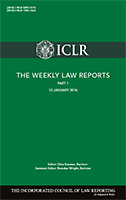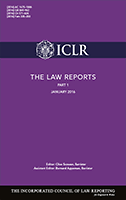ICLR’s Law Reports: An Explainer
It is fair to say that law reporting probably strikes quite a few people out there as being a rather arcane business. The purpose of this post is to try to make things a little less obscure by explaining the various types of law report published by ICLR. Whether you’re just about to begin studying
It is fair to say that law reporting probably strikes quite a few people out there as being a rather arcane business. The purpose of this post is to try to make things a little less obscure by explaining the various types of law report published by ICLR.
Whether you’re just about to begin studying law or have been practising for years, we hope that you find what follows useful.
The five series of reports
ICLR currently publish five series of law reports. They are:
- The Law Reports
- The Weekly Law Reports
- The Industrial Cases Reports
- The Business Law Reports
- The Public & Third Sector Law Reports
Each of the five series of law reports listed above broadly follow the same style and structure. The reports in each series all consist of the following common elements:
- A case header – the section that sets out the names of the parties (e.g. Donoghue v Stevenson), the dates of the hearing and judgment, the court and the judge(s)
- Catchwords – the section that sets out the keywords attaching to the case (e.g. Crime – Evidence – Hearsay) and the key issues in the case (e.g. Whether such and such evidence was admissible)
- Headnote – the section where the law reporter sets out the factual background of the case, the decision of the court and other relevant information, such as whether an earlier case was applied or reversed, etc.
- Blocklists – lists of all of the cases referred to in the judgment(s), in oral argument and in the skeleton arguments
- Procedure – sets out the procedural background to the case
- The judgment(s)
Despite these common features, there are few points of difference between our various series and a number of “quirks” that set them apart.
The Weekly Law Reports
Let’s start with ICLR’s core series of reports, The Weekly Law Reports.

The Weekly Law Reports is a “generalist” series of reports. This means that this series of reports provides coverage of cases in all areas of the law (so, criminal cases sit alongside tax cases, and chancery cases sit alongside human rights cases, etc).
The series entered publication in 1953 with the purpose of providing frequent (weekly) coverage of all of the important cases decided in England & Wales.
For a case to be reported in The Weekly Law Reports, it must:
- Decide a new point of law; or
- Modify an existing point of law; or
- Explain an existing point of law; or
- Provide useful guidance on how a particular principle of law is to be applied
Where we determine that a case does not possess one of the four qualities listed above, we will not report it.
The Weekly Law Reports citation looks like this: [2015] 1 WLR 123. Whenever you see a case reference with a citation consisting of the abbreviation “WLR”, this signifies that a report of the case can be found in The Weekly Law Reports.
Now for the quirk…
The Weekly Law Reports is made up of three volumes – volumes 1, 2 and 3.
Where a case is reported in volume 2 or 3, this means that the case is of special importance and will be reported again in The Law Reports (read on to find out more about these). So, if you see a citation that looks like this [2015] 2 WLR 123, or this [2015] 3 WLR 456, you should check to see if the case has appeared in The Law Reports, which is the most authoritative series of reports in the UK.
Cases reported in volume 1 (i.e. with a citation that looks like this [2015] 1 WLR 789) are significant enough for inclusion in The Weekly Law Reports, but do not reach the threshold of importance to be included in The Law Reports.
On average, we report around 330 cases in The Weekly Law Reports per year.
Decisions of the High Court, both divisions of the Court of Appeal, the Supreme Court, Privy Council and the Court of Justice of the European Union are reported in The Weekly Law Reports.
[UPDATE: From 2016 a fourth volume of WLR was added. This additional volume is only accessible online, and contains additional cases which, while not meriting full print publication, add useful knowledge and provide helpful recent examples of the application of settled law, in a form that can be cited as a complete case report. For more on this, see Expanding The Weekly Law Reports – Introducing Volume 4]
The Law Reports

The Law Reports is ICLR’s flagship series and is the most authoritative series of law reports in the UK. The series entered publication in 1865 and has been in circulation ever since.
Like The Weekly Law Reports, The Law Reports is a “generalist” series of reports, so all areas of law are covered.
Since 1890, The Law Reports has been divided into four divisions:
- Appeal Cases – this division covers decisions of the Supreme Court (formerly the House of Lords). The citation for this division looks like this: [2015] 1 AC 123
- Queen’s Bench – this division provides coverages of common law decisions from the High Court, Court of Appeal and the Court of Justice of the European Union. The citation for this division looks like this: [2015] 1 QB 345
- Chancery – this division provides coverage of chancery matters (i.e. cases involving wills, trusts and intellectual property etc). The citation for this division looks like this: [2015] 1 Ch 567
- Family – this division covers family law. The citation looks like this [2015] Fam 789
The cases selected for reporting in The Law Reports possess special significance going beyond the mere fact that they decide a new point of law or modify and existing principle. Generally, a case will have this “something special” if we assess the decision as representing a long term development in the law or if the case has potential for application beyond its own subject matter.
There are three important things to note about The Law Reports:
- Virtually all of the cases reported in The Law Reports will have first been reported in volume 2 or 3 of The Weekly Law Reports. So, as we explain above, if you see a reference that looks like this [2015] 2 WLR 123, or this [2015] 3 WLR 456, you should check to see if a report of the case is available in The Law Reports, because the version in The Law Reports is the most authoritative.
- Reports of cases in The Law Reports include a feature unique to the series: there is a note of the arguments made by counsel before the court. No other series of reports in the UK provides a note of the argument.
- As a matter of practice, where a case is reported in The Law Reports, you should cite that version in preference to any other. See Practice Direction (Citation of Authorities) [2012] 1 WLR 780 at para 6:
Where a judgment is reported in the official Law Reports (AC, QB, Ch, Fam) published by the Incorporated Council of Law Reporting for England and Wales, that report must be cited. These are the most authoritative reports; they contain a summary of the argument. Other series of reports and official transcripts of judgment may only be used when a case is not reported in the official Law Reports.
The “Specialist” Series
The Industrial Cases Reports, The Business Law Reports and The Public & Third Sector Law Reports are “specialist” rather than “generalist” in the sense that they provide coverage of specific areas of law.
- The Industrial Cases Reports, which has been published since 1972, provide coverage of employment law cases, case involving discrimination and cases involving some other form of industrial dispute.
- The Business Law Reports, which has been published since 2007 deals with company, commercial and intellectual property orientated cases.
- And, finally, the Public & Third Sector Law Reports (published since 2009) provides coverage of cases involving local authorities, charities and the church.
Where can these reports be accessed from?
The law reports published by ICLR are accessible in the form of printed books and online.
Most university law libraries will hold printed copies of The Law Reports and The Weekly Law Reports. In the UK, ICLR’s law reports are available online through the following providers:
- ICLR Online (ICLR’s own online research platform at iclr.co.uk)
- WestlawUK
- LexisLibrary